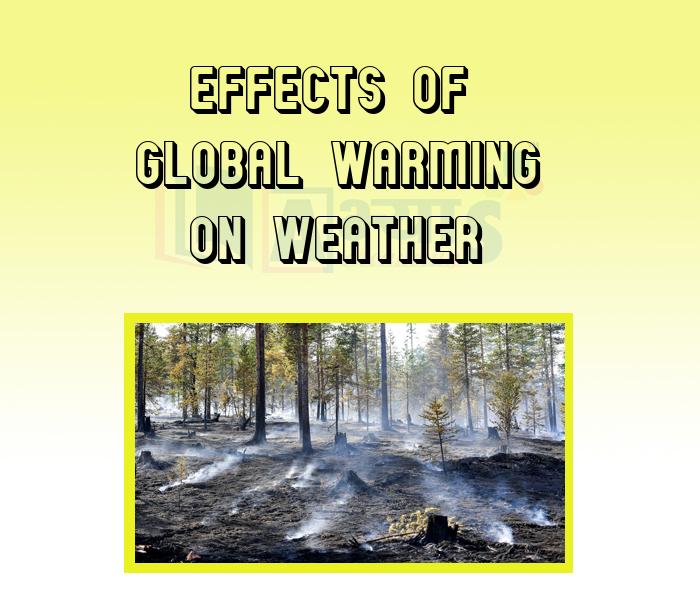Effects Of Global Warming On Weather










Effects Of Global Warming On Weather
Effect Of Global Warming on Weather: The various effects are:
1. Extreme Weather: Storm strength leading to extreme weather is increasing, such as the power dissipation index of hurricane intensity. Severe weather and moderate rainfall are also increasing. Increases in temperature are expected to produce more intense convection over land and a higher frequency of the most severe storms
2. Increased Evaporation: As the climate grows warmer and the causes of global dimming are reduced, evaporation will increase due to warmer oceans. Because the world is a closed system, this will cause heavier rainfall, with more erosion. This erosion, in turn, can lead to desertification in vulnerable tropical areas (especially in Africa due to deforestation.
3. Glacier Retreat and Disappearance: The loss of glaciers not only directly causes landslides, flash floods and glacial lake overflow, but also increases annual variation in water flows in rivers. Glacier runoff declines in summers as glaciers decrease in size; this decline is already observable in several regions. Glaciers retain water on mountains in high precipitation years, since the snow cover accumulating on glaciers protects the ice from melting. In warmer and drier years, glaciers offset the lower precipitation amounts with a higher melt water input,
4. Sea Level Rise: With increasing average global temperature, the water in the oceans expands in volume, and additional water enters them, which had previously been locked up on land in glaciers. The IPCC predicts that sea levels could rise by as much as 59 cm this century. The geological record suggests that ice at the poles does not melt in a gradual and linear fashion, but flips suddenly from one state to another. When temperatures increased to 2-3 degrees above today's level 3.5 million years ago, sea levels rose not by 59 centimetres but by 25 metres. The ice responded immediately to changes in temperature.
5. Acidification: The world's oceans soak up much of the carbon dioxide produced by living organisms, cither as dissolved gas, or in the skeletons of tỉny marine creatures that fall to the bottom to become chalk or limestone.Oceans currently absorb about one tone of Carbon Dioxide per person per year. It is estimated that the oceans have absorbed around half of all Carbon Dioxide generated by human activities since 1800. However, in water, carbon dioxide becomes a weak carbonic acid, and the increase in the greenhouse gas since the industrial revolution has already lowered the average pH.
Students / Parents Reviews [10]
It was good as the experience because as we had come here we had been improved in a such envirnment created here.Extra is taught which is beneficial for future.

Eshan Arora
8thBeing a parent, I saw my daughter improvement in her studies by seeing a good result in all day to day compititive exam TMO, NSO, IEO etc and as well as studies. I have got a fruitful result from my daughter.

Prisha Gupta
8thIt was a good experience with Abhyas Academy. I even faced problems in starting but slowly and steadily overcomed. Especially reasoning classes helped me a lot.

Cheshta
10thOne of the best institutes to develope a child interest in studies.Provides SST and English knowledge also unlike other institutes. Teachers are co operative and friendly online tests andPPT develope practical knowledge also.

Aman Kumar Shrivastava
10thAbhyas Methodology is very good. It is based on according to student and each child manages accordingly to its properly. Methodology has improved the abilities of students to shine them in future.

Manish Kumar
10thMy experience with Abhyas is very good. I have learnt many things here like vedic maths and reasoning also. Teachers here first take our doubts and then there are assignments to verify our weak points.

Shivam Rana
7thMy experience with Abhyas academy is very good. I did not think that my every subject coming here will be so strong. The main thing is that the online tests had made me learn here more things.

Hiya Gupta
8thAbout Abhyas metholodology the teachers are very nice and hardworking toward students.The Centre Head Mrs Anu Sethi is also a brilliant teacher.Abhyas has taught me how to overcome problems and has always taken my doubts and suppoeted me.

Shreya Shrivastava
8thI have spent a wonderful time in Abhyas academy. It has made my reasoning more apt, English more stronger and Maths an interesting subject for me. It has given me a habbit of self studying

Yatharthi Sharma
10thIt has a great methodology. Students here can get analysis to their test quickly.We can learn easily through PPTs and the testing methods are good. We know that where we have to practice
